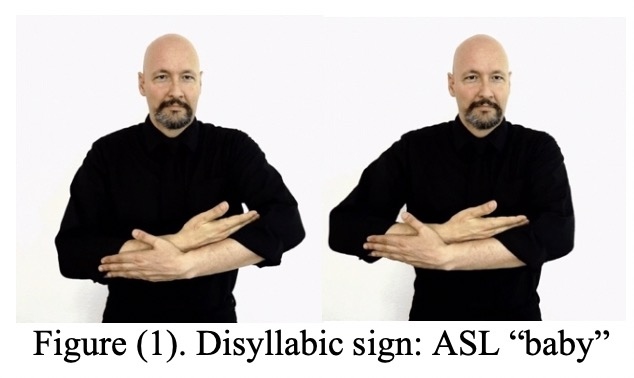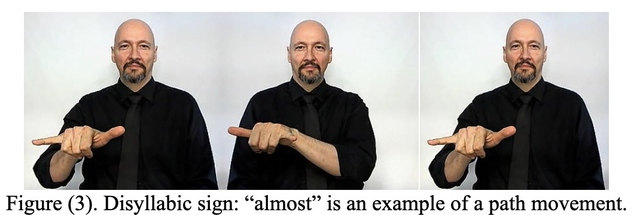Evidence of Syllables in American Sign Language
By
2019, Vol. 11 No. 12 | pg. 1/1
IN THIS ARTICLE
KEYWORDS
AbstractThis paper will focus on the meaning of signed-language syllables, or the signed-syllable, in American Sign Language (ASL). It is assumed that syllables are applicable to ASL because the phonological representation can be seen in each individual hand movement. It is also interpreted as such by native speakers. This is important because it establishes credibility in the signed language, which is the initial step towards greater ASL accessibility. In America, The Deaf Culture makes up 13% of the overall population, according to Gallaudet University’s Deaf Statistics research. Upon further statistical deconstruction, the National Institute of Deafness and Other Communication Disorders, (NIDCD), has determined that over 90% of deaf children in the United States are born to hearing parents who have had no previous exposure, or knowledge of ASL. Deaf children with hearing parents do not gain access to language during the early stages of development. These children are born with a severe delay in language acquisition, which hinders cognitive development, resulting in lower academic performance. By arguing the presence of syllables in ASL, this paper will raise phonological awareness, while also demonstrating ways in which ASL shares the same meta linguistic elements with spoken English, such as phonology, through cross-linguistic analysis. ASL should be offered as a foreign language option in all educational institutions. My overall goal is to increase metalinguistic skills in deaf children, giving them the same advantage as hearing children. According to What is A Syllable by W. L. Schramm, a syllable is defined as, "sound uttered with a single impulse or effort of the voice and constituting a word or a part of a word.” (Schramm 552) In spoken languages, syllables operate as systems of expressing phonotactic constraints on consonant and vowel combinations. In ASL, this abstract operation can be expressed by movement of the hand, or movement of only the fingers, which is known as a path movement or local movement. (Ormel, Crasborn 2012) In Sign Language Structure, William C. Stokoe explains this alternate language modality in greater detail: “The structure of a sign, [ASL] however, permits considerable linguistic latitude, even as does a spoken word, because the sign itself is not an isolate or an encoded form of writing the word but a construction made from elements that themselves admit of linguistic variation.” (Stokoe, 1978 p. 30) Signs can be deconstructed into a nominal phonological constructional framework, and they also contain metalinguistic communitive phenomena that are governed by parallel cognitive processes. Similar to English, American Sign Language (ASL) is depicted with the same procedures as the spoken language, and it also requires the same left-side brain lateralization. (Carreiras, Baus 2014) Stokoe (1978) establishes that signs can be decomposed into main phonological constituents or formational parameters, which are handshape, formation, and movement; each of these elements play a unique role in ASL language processing. This required linguistic processing can be taken as evidence for modality-dependence within both languages, but I will focus only on the modality-dependence in ASL, in comparison to verbal language.Evidence of ASL as a Prosodic LanguageThe inner-mappings of signs are different from the sophisticated units of spoken morphemes, and they occur simultaneously, rather than subsequently, unlike English. (Stokoe 1978) In contrast, ASL is the other natural language modality that contains syllables. In order to effectively argue the existence of syllables in ASL, it must first be understood that they are a prosodic unit of groupings within a word, that includes similar patterns of rhythms and sounds used in poetry. Before linguists began intensively studying ASL, it was considered a manual language that is produced only by the signer’s hands. However, Stokoe (1978) and many other linguisticians, have established that signed languages are communicated through hand gestures, along with other prosodic cues, to mark boundaries, communicate discourse functionality, and to also emphasize chosen elements of the sentence. There is much debate over whether prosody and syntax are directly connected, or if prosody interacts with syntax via semantics. Either way, the prosody-syntax interface still encompasses necessary prosodic cues, which marks intonational phrases, (I-phrases), and is essential in the perception and production of each signed utterance. (Brentari, Falk, Wolford 2015) This is significant to establishing the syllable in ASL, because they are derived from this visual-manual versification. Prosodic cues are defined as, “…properties of movements for which parallels can be found in spoken languages.” (Brentari, Falk, Wolford 2015) The ASL prosodic profile is made of intonational phrases (I-phrases) or, the fall and rise of spoken tone, which are associated with seven primary cues. These cues are separated into two classes, manual cues and boundaries, or nonmanual markers (NMM). Manual cues include, sign lengthening, pause lengthening, and hold lengthening. Boundaries include, eye blinks, brow-position changes, body position, and head position. (Brentari, Falk, Wolford 2015) This stream of language contains sounds, movements, handshapes, syllables, and word-phrases which belong to linguistic subsystems that are interrelated, resulting in connected discourse that is either segmental or non-segmental quantums of sound structure. (Brentari,1998) NMM’s and manual cues are important in ASL, because they mark utterances and I-phrases during signed conversation, signaling breaks between physical signs, cognitive thoughts, and abstract messages that are being communicated. Syllables in ASLUnderstanding how the communicative properties of ASL are broken down into prosodic cues, provides clearer insight into the structure of signs. The signed syllable is a unit of phonological organization that represents the timing of handshape change. (Brentari, Falk, Wolford 2015)
This is supported by the stress position in disyllabic signs such as “baby” (see Figure 1) In the spoken form of the word, the second syllable is stressed; the same is applied to the non-verbal modality. The sign for “baby” consists of a back-and-forth rocking motion, arms cradled, from left to right. The left movement is shorter than the right movement, and the elbows are slightly elevated to the right at the end of the path movement, making the right-side cradle higher than the left, thus, visually stressing the second syllable. After signing this word, the signer would pause briefly, a manual prosodic cue, before continuing with the next sign; this collective method results in a rhythmic stream of language. The Syllable in Sign Language argues that, “…signs with one movement (or two simultaneously) are the optimal form in sign languages. As the syllable is not isomorphic with the word…” (Sandler 2015) Most signs are monosyllabic are most common in signed languages, regardless of their morphological structure and are, “distinguished by their cooccurrence patterns.” (Sandler 2015) resulting in a clear modality effect. This can be attributed to the architectural progression of sign formation, because some signs are reduced, from two or more signs, to only one, depending on the word being represented. Sandler (2015) uses the word “faint” to explain how some signs are derived from compounds of other signs. (see Figure 2)
“Faint” is combination of the signs “mind” and “drop,” but instead of being expressed in two different consecutive signs, it is reduced to one fluid sign, and therefore, becoming monosyllabic. (see Figure 2) This is significant, because the signed syllable is a component of phonological organization, (Sandler 2015) and the change in handshape timing coincides with transitional movements within syllables, providing further structural proof that they do exist. Similarities Between ASL and Verbal English.Like spoken languages, ASL contains syllables, which contributes to linguistic organization within words and signs. In both modalities, syllables act as proverbial anchors for smaller, meaningless morphological structures, giving them meaning and also providing insight to their morpho-phonological developments. In ASL, we see this through path-movements or internal movements. (Brentari, 1998) Path movements occur when the hand(s) travel from one location to another; internal movements are when the hand(s) move, without changing location, i.e. opening and closing of the fingers.
For example, in the sign for “also,” (see Figure 3) the hand begins in one location, and moves to a different location, were it ends. This path movement is directly connected to the syllables in the word, since the vocalized “al” coincides with the beginning path movement, and “most” coincides with the third path movement, which is also the end location. However, this dos not signify that verbal syllables will coincide with hand movements. There are two spoken syllables in “almost,” but three hand-location changes. Internal movements serve the same purpose of anchoring syllables to smaller morphological units.
In “ant” the location of the sign does not change, (see Figure 4) but only the fingers wiggle up-and-down. This breakdown reveals how both the spoken and signed syllables explain the morpho-phonological processes of how they organize lower units of the phonetic structure, and in doing so, uncovers intricate similarities such as their prosodic nature. (Brentari,1998) Another distinct similarity that is worth mentioning, is that neither ASL nor spoken languages are isomorphic with morphosyntactic structure. (Sandler 2015) The syllable and the word do not correspond in form, as shown in Figure (3). This structure does not impact word-prosody, nor does it determine if it is monosyllabic or not; furthermore, the syllable, not the morpheme, receives the stress in both procedures. Differences Between ASL and Verbal EnglishThe similarities between ASL and English provide evidence that acquisition of both languages require the same intellectual processes, but the differences argue that the overall phonological structure is conditional to the physical transmission system of the language. (Brentari,1998) Fundamentally, the visual-manual modalities differ in physical conduction of the language. With spoken languages, the Oscillating Mandible is used to produce tone and intonation. In ASL, the hand is the voiceless counterpart that is used to project the desired articulatory range, and facial expressions convey the intended tones. Which also results in the different utterance dimensions between signed and spoken languages. English is constricted by the physical construct of the jawbone; the oscillation of the mandible is limited to a back-and-forth movement, similar to a pendulum. With ASL, the hand and fingers allows articulatory freedom because of the vast combination possibilities. Sandler further explains how the hand has greater articulatory range within signed languages,
Because of this, language-creativity supersedes that of spoken languages, and by definition, signed languages have more variety of tones and intonations than spoken languages. Aside from the dimensional and inflectional differences, ASL does not possess the ability to communicate consonant clusters and other vocal blends. To do this, signs would need to convey clusters from two different locations, and according to Sandler, Due to the nature of the system, there must be a movement between any two different locations. Similarly, any path movement must by definition traverse the space between two locations, so that it would also be difficult to argue for movement clusters (diphthong-like entities) within a single syllable. (Sandler 2015) Hand coordination needs to be considered here. Since expressing constant clusters would require both hands, moving in different ways at the same time, it is clear how this would not be a clear form of communication. The absence of coda-rhyme asymmetry is another difference between ASL and English. This is something that can be displayed only through inflection of audible speech. When signing, the last “l” in “fall” contains the same articulatory features as the “l” in “ball,” without distribution of intonational tones. Rhyming in spoken languages is created with repetition of similar sounds, but in ASL, it is produced through repetition of similar signs to create a ‘visual rhyme’. The phonological constituents must be the same, i.e. handshape, palm orientation, movement, in order to create visual repetition. American Sign Language is not the same as spoken English, nor is it a visual mimicry of audible speech. ASL has its own syntax, grammar, origin, and other communication styles that differ from English, but it does share enough significant similarities to spoken languages to effectively establish that it is its own unique language. Syllables share a role in helping distinguish ASL, and other signed languages, by providing morphological proof that even though the prose is voiceless, it carries important communicative properties. Furthermore, the same cognitive processes that are required for spoken-language acquisition are also required for signed-language acquisition. Children acquire signed languages the same way hearing children acquire signed languages, which further argues Chomsky’s theory of Universal Grammar. Deaf children are born with the same innate language-learning capabilities, and they also must acquire language before puberty, or language will not be acquired or learned at all. Collectively, this further recognizes the syllable from other morphological aspects of the sign, strengthening the credibility of the language. ReferencesBaus C, Gutiérrez E, Carreiras M. The role of syllables in sign language production.Frontiers in Psychology. 2014; 5:1254. doi:10.3389/fpsyg.2014.01254. Beckman, M., Edwards, J., 1990. Lengthenings and shortenings and the nature of prosodic constituency. In: Kingston, J., Beckman, M. (Eds.), Papers in Laboratory Phonology 1: Between the Grammar and Physics of Speech. Cambridge University Press, Cambridge, pp. 152–178. Brentari, D., Falk, J., & Wolford, G. (2015). The Acquisition of Prosody in American Sign Language.Language,91(3), e144-e168. Coulter, G., 1990. Emphatic stress in ASL. In: Fischer, S., Siple, P. (Eds.), Theoretical Issues in Sign Language Research. Vol. 1: Linguistics. University of Chicago Press, Chicago, pp. 109–125. Hayes, B.,1993. Against movement: comments on Liddell’s article. In: Coulter, G. (Ed.), Phonetics and Phonology. Vol. 3: Current Issues in ASL Phonology. Academic Press, San Diego, pp. 213–226. Malaia E, Wilbur RB. Early acquisition of sign language: What neuroimaging data tell us.Sign language and linguistics. 2010;13(2):183-199. Morgan G (2014) On language acquisition in speech and sign: development of combinatorial structure in both modalities.Front. Psychol.5:1217.doi: 10.3389/fpsyg.2014.01217 Newport, E., Meier, R., 1985. The acquisition of American Sign Language. In: Slobin, D. (Ed.), The Cross-Linguistic Study of Language Acquisition, Volume 1 (pp. 881-938). Ormel, E., & Crasborn, O. (2012). Prosodic correlates of sentences in signed languages: a literature review and suggestions for new types of studies.Sign Language Studies,12(2), 279-315. Study of Language Acquisition. Lawrence Erlbaum Associates, Hillsdale, NJ, pp. 881–938. Schramm, W. L. (1935). What is a syllable.The Scientific Monthly,40(6), 552-555. Suggested Reading from Inquiries Journal
Inquiries Journal provides undergraduate and graduate students around the world a platform for the wide dissemination of academic work over a range of core disciplines. Representing the work of students from hundreds of institutions around the globe, Inquiries Journal's large database of academic articles is completely free. Learn more | Blog | Submit Latest in Linguistics |























